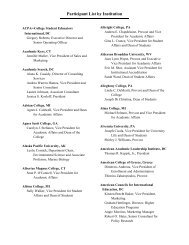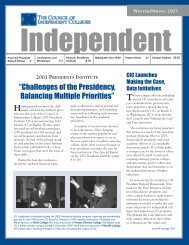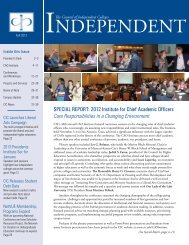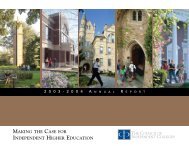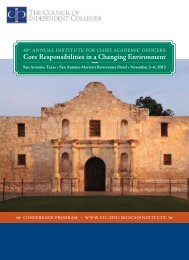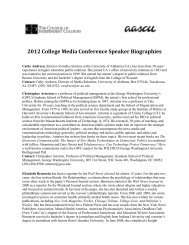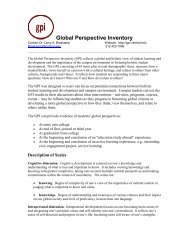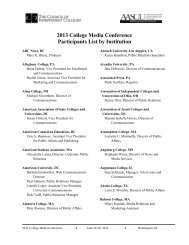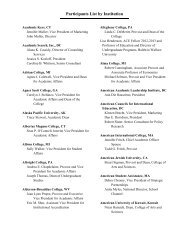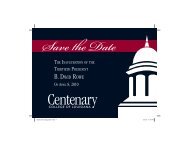Summer 2009 - The Council of Independent Colleges
Summer 2009 - The Council of Independent Colleges
Summer 2009 - The Council of Independent Colleges
You also want an ePaper? Increase the reach of your titles
YUMPU automatically turns print PDFs into web optimized ePapers that Google loves.
ConFerences<br />
Major Media, Near-Record Attendance Factored<br />
in Success <strong>of</strong> College Media Conference<br />
Despite dramatic changes in the economy that have restricted<br />
college and university travel budgets—and led to drastic<br />
cutbacks in the news industry—the <strong>2009</strong> College Media<br />
Conference attracted a significant number <strong>of</strong> the nation’s most<br />
prominent higher education media representatives and nearrecord<br />
attendance. More than 230 participants, including more<br />
than 200 communications <strong>of</strong>ficers from public and private, large<br />
and small colleges and universities in 38 states, attended the 23rd<br />
annual conference, cohosted for the first time by CIC and the<br />
American Association <strong>of</strong> State <strong>Colleges</strong> and Universities.<br />
Held June 22–24 in Baltimore, Maryland, the<br />
event featured reporters and editors from the Wall<br />
Street Journal, CNN International, NBC’s Today<br />
Show, U.S. News & World Report, Inside Higher<br />
Ed, New York Times, USA Today, Washington<br />
Post, Newsweek, National Public Radio,<br />
Chronicle <strong>of</strong> Higher Education, Huffington Post,<br />
and Science News.<br />
One participant described the event as “by<br />
far the best opportunity for college media relations<br />
pr<strong>of</strong>essionals to discuss what they do. Interacting with this<br />
group is a good part <strong>of</strong> the value.” Another said, “I am amazed<br />
at the quantity and quality <strong>of</strong> the A-list media people who<br />
participated. I came away with new perspectives <strong>of</strong> the process<br />
that I plan to apply ASAP.”<br />
<strong>The</strong> media panelists discussed the devastating changes in<br />
the news media—including lay<strong>of</strong>fs, cutbacks, and buyouts that<br />
are decimating the ranks <strong>of</strong> reporting staff at most media outlets<br />
nationwide. Many said that reporters who had covered higher<br />
education as a beat are being reassigned or their publications are<br />
reducing education coverage overall. Jane Karr, Education Life<br />
editor at the New York Times, said education coverage at the Times<br />
is now decentralized. “<strong>The</strong>re is no longer an education editor—<br />
everybody covers education now, including sports, lifestyle,<br />
metro, business—so PR <strong>of</strong>ficers need to rethink how and to<br />
whom they pitch a story.” Other media panelists explained how<br />
college and university PR/media <strong>of</strong>ficers can interact effectively<br />
with them as they report on higher education issues, provided<br />
specific examples <strong>of</strong> what they were looking for in a story, and<br />
described how their publication is changing. <strong>The</strong> conference<br />
also featured panel discussions by college and university public<br />
relations pr<strong>of</strong>essionals who shared best practices and approaches<br />
to publicizing campus activities and pitching stories to the media.<br />
Networking with colleagues in communications, marketing,<br />
and media and public relations from around the country was<br />
described by some participants as one <strong>of</strong> the major benefits <strong>of</strong> the<br />
conference.<br />
Among the topics discussed were “Satisfying the Editor’s<br />
Demands,” “Understanding National Education Reporters,”<br />
“Crystal Ball Gazing: Future <strong>of</strong> the News Media,” “Publicizing<br />
Science and Research Experts,” “New Media and Fresh Ideas<br />
for Promoting Faculty Members,” “Getting Coverage for the<br />
Institution,” “Public Policy and the Year Ahead,” “Approaching<br />
Network TV Shows,” “PIOnet Review: What’s on Media Officers’<br />
Minds,” and “Understanding Daily Newspapers.”<br />
Many participants at the conference were eager to<br />
explore social media and networking tools such as<br />
Twitter, Facebook, and blogs and how they are used<br />
by the media. Dozens <strong>of</strong> attendees took advantage<br />
<strong>of</strong> the Twitter “hashtag” (cmc<strong>2009</strong>) established<br />
for the conference.<br />
<strong>The</strong> University <strong>of</strong> Maryland was the premier<br />
sponsor <strong>of</strong> the conference; other sponsors<br />
included readMedia, Eurekalert!, and Allegheny<br />
College (PA).<br />
Resources from the conference, including<br />
the <strong>2009</strong> Higher Education Media Contacts List, are<br />
available at www.collegemediaconference.org/resources.html.<br />
Journalists Dee Dee Thomas (right) from NBC’s Today Show, Callie Crossley<br />
(middle right) from CNN’s Reliable Sources and NewsHour with Jim Lehrer,<br />
and Cory Charles (far right) from CNN International answer questions from<br />
participants in the <strong>2009</strong> College Media Conference in Baltimore, Maryland.<br />
<strong>Independent</strong> | <strong>Summer</strong> <strong>2009</strong> 9



